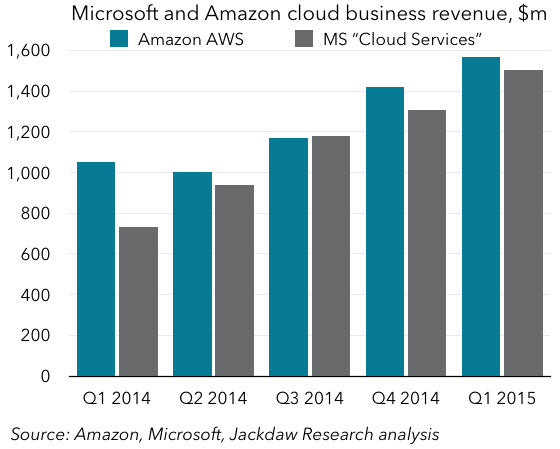Amazon finally provided the first direct visibility over the finances associated with its AWS business today, and it provides an opportunity to compare them with one of the other two big enterprise cloud businesses which compete with it, Microsoft’s. Microsoft doesn’t explicitly report its cloud revenues, but “Commercial Cloud” is one of a number of revenue categories it provides enough detail around in its 10-Q to allow us to calculate it with some accuracy. Here, then, is a comparison of Amazon’s AWS revenues and Microsoft’s Commercial Cloud revenues over the same five quarters:
 As you can see, the two are almost neck and neck at this point, with Microsoft’s cloud revenues catching up to Amazon’s over time. It seems likely that they will pass AWS revenues in the next couple of quarters. But the obvious problem with this chart is that they’re not measuring the same thing: AWS is a discrete business, largely focused on public cloud services, whereas Microsoft’s revenues reflect several quite different businesses that it’s lumped together under this heading. However, this reflects something I wrote about last quarter, which is that Amazon would actually quite like to have a cloud business that looks more like Microsoft’s:
As you can see, the two are almost neck and neck at this point, with Microsoft’s cloud revenues catching up to Amazon’s over time. It seems likely that they will pass AWS revenues in the next couple of quarters. But the obvious problem with this chart is that they’re not measuring the same thing: AWS is a discrete business, largely focused on public cloud services, whereas Microsoft’s revenues reflect several quite different businesses that it’s lumped together under this heading. However, this reflects something I wrote about last quarter, which is that Amazon would actually quite like to have a cloud business that looks more like Microsoft’s:
It continues to be critical for both companies (and Google) to migrate their way up the cloud stack to the higher-layer services (as both I and Nadella called them), but Microsoft is already there, while Amazon continues to try to compete in a space I’m really not sure they can.
Where the two businesses overlap, Amazon’s is certainly quite a bit larger, but Microsoft’s cloud business looks a lot like the kind of business Amazon is trying to build, and quite rightly. The kind of business Amazon is in today is rapidly commoditizing, and its chances of moving up the stack are much slimmer than Microsoft’s, which has a much longer history in this space and a massive legacy customer base to migrate over to it.
One other thing we don’t know about Microsoft’s cloud business is its profitability. It sits within the Commercial Other category at Microsoft, which reports gross margins of 41% last quarter, but those margins have been rising rapidly as Microsoft builds scale in this business. Amazon’s operating margins on AWS, meanwhile, are far higher than in its core e-commerce business, but they appear to have fallen quite a bit year on year, likely reflecting that commoditization and the increasing competition in this space. I’m not sure Amazon will be able to turn those margins around in the near future unless it is able to execute that transition to higher-stack services and therefore better differentiate its offerings. Microsoft’s trend currently looks healthier on both the revenue growth and margin side. And of course Microsoft has quite a few other more profitable segments to lean on while it builds this business, whereas Amazon continues to struggle to break even in its core business.